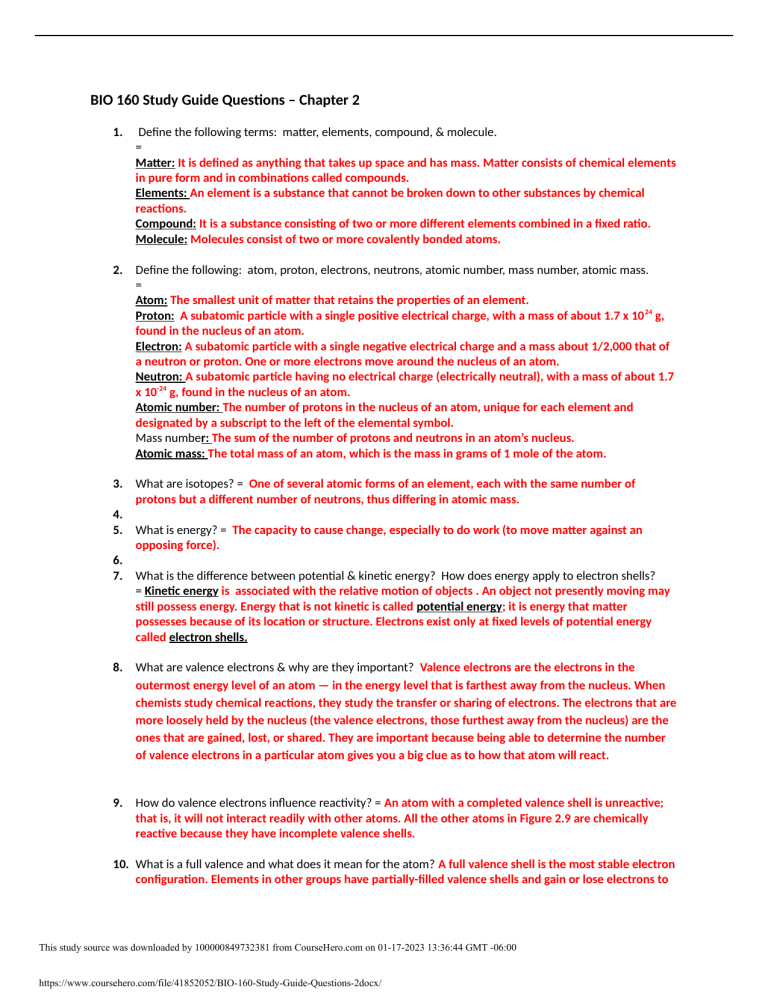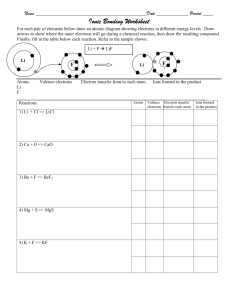
BIO 160 Study Guide Questions – Chapter 2 1. Define the following terms: matter, elements, compound, & molecule. = Matter: It is defined as anything that takes up space and has mass. Matter consists of chemical elements in pure form and in combinations called compounds. Elements: An element is a substance that cannot be broken down to other substances by chemical reactions. Compound: It is a substance consisting of two or more different elements combined in a fixed ratio. Molecule: Molecules consist of two or more covalently bonded atoms. 2. Define the following: atom, proton, electrons, neutrons, atomic number, mass number, atomic mass. = Atom: The smallest unit of matter that retains the properties of an element. Proton: A subatomic particle with a single positive electrical charge, with a mass of about 1.7 x 10 24 g, found in the nucleus of an atom. Electron: A subatomic particle with a single negative electrical charge and a mass about 1/2,000 that of a neutron or proton. One or more electrons move around the nucleus of an atom. Neutron: A subatomic particle having no electrical charge (electrically neutral), with a mass of about 1.7 x 10-24 g, found in the nucleus of an atom. Atomic number: The number of protons in the nucleus of an atom, unique for each element and designated by a subscript to the left of the elemental symbol. Mass number: The sum of the number of protons and neutrons in an atom’s nucleus. Atomic mass: The total mass of an atom, which is the mass in grams of 1 mole of the atom. 3. What are isotopes? = One of several atomic forms of an element, each with the same number of protons but a different number of neutrons, thus differing in atomic mass. 4. 5. 6. 7. What is energy? = The capacity to cause change, especially to do work (to move matter against an opposing force). What is the difference between potential & kinetic energy? How does energy apply to electron shells? = Kinetic energy is associated with the relative motion of objects . An object not presently moving may still possess energy. Energy that is not kinetic is called potential energy; it is energy that matter possesses because of its location or structure. Electrons exist only at fixed levels of potential energy called electron shells. 8. What are valence electrons & why are they important? Valence electrons are the electrons in the outermost energy level of an atom — in the energy level that is farthest away from the nucleus. When chemists study chemical reactions, they study the transfer or sharing of electrons. The electrons that are more loosely held by the nucleus (the valence electrons, those furthest away from the nucleus) are the ones that are gained, lost, or shared. They are important because being able to determine the number of valence electrons in a particular atom gives you a big clue as to how that atom will react. 9. How do valence electrons influence reactivity? = An atom with a completed valence shell is unreactive; that is, it will not interact readily with other atoms. All the other atoms in Figure 2.9 are chemically reactive because they have incomplete valence shells. 10. What is a full valence and what does it mean for the atom? A full valence shell is the most stable electron configuration. Elements in other groups have partially-filled valence shells and gain or lose electrons to This study source was downloaded by 100000849732381 from CourseHero.com on 01-17-2023 13:36:44 GMT -06:00 https://www.coursehero.com/file/41852052/BIO-160-Study-Guide-Questions-2docx/ achieve a stable electron configuration. An atom may gain or lose electrons to achieve a full valence shell, the most stable electron configuration. 11. What is a covalent bond? = A type of strong chemical bond in which two atoms share one or more pairs of valence electrons. 12. What is the difference between Lewis dot structures, structural formulas, and molecular formulas? = Figure 2.12 a shows several ways of representing a hydrogen molecule. Its molecular formula, H2, simply indicates that the molecule consists of two atoms of hydrogen. Electron sharing can be depicted by an electron distribution diagram or by a Lewis dot structure, in which element symbols are surrounded by dots that represent the valence electrons (H:H). We can also use a structural formula, H¬H, where the line represents a single bond, a pair of shared electrons. A space-filling model comes closest to representing the actual shape of the molecule. 13. What creates a double bond? = A double covalent bond; the sharing of two pairs of valence electrons by two atoms. 14. What is a chemical bond? = An attraction between two atoms, resulting from a sharing of outer-shell electrons or the presence of opposite charges on the atoms. The bonded atoms gain complete outer electron shells. This study source was downloaded by 100000849732381 from CourseHero.com on 01-17-2023 13:36:44 GMT -06:00 https://www.coursehero.com/file/41852052/BIO-160-Study-Guide-Questions-2docx/ 15. What are the differences in nonpolar covalent bonds, covalent bonds, & hydrogen bonds? = A nonpolar covalent bond is formed between same atoms or atoms with very similar electronegativities—the difference in electronegativity between bonded atoms is less than 0.5. Covalent bond: This bond is formed between atoms that have similar electronegativities—the affinity or desire for electrons. Because both atoms have similar affinity for electrons and neither has a tendency to donate them, they share electrons in order to achieve octet configuration and become more stable. Hydrogen bonding is a relatively strong force of attraction between molecules, and considerable energy is required to break hydrogen bonds. It plays an important role in biology; for example, hydrogen bonds are responsible for holding nucleotide bases together in DNA and RNA. 16. What is the valence of an atom? = The bonding capacity of a given atom; usually equals the number of unpaired electrons required to complete the atom’s outermost (valence) shell. Valence determines how many atoms of an element a particular atom can combine with. 17. What is electronegativity? = Atoms in a molecule attract shared electrons to varying degrees, depending on the element. The attraction of a particular atom for the electrons of a covalent bond is called its electronegativity. The more electronegative an atom is, the more strongly it pulls shared electrons toward itself. 18. What are ionic bonds & ionic compounds? The attraction between oppositely charged atoms, or ions, is an ionic bond. An ionic bond can form between any two oppositely charged ions, even if they have not been formed by transfer of an electron from one to the other. Compounds formed by ionic bonds are called ionic compounds, or salts. 19. Define ion, cation, & anion. = A charged atom (or molecule) is called an ion. When the charge is positive, the ion is specifically called a cation. An anion is a negatively charged ion. 20. What causes Van der Waals interactions? Give an example of one? = Even a molecule with nonpolar covalent bonds may have positively and negatively charged regions. Electrons are not always symmetrically distributed in such a molecule; at any instant, they may accumulate by chance in one part of the molecule or another. The results are ever-changing regions of positive and negative charge that enable all atoms and molecules to stick to one another. These Van der Waals interactions are individually weak and occur only when atoms and molecules are very close together. When many such interactions occur simultaneously, however, they can be powerful: Van der Waals interactions are the reason a gecko lizard (right) can walk straight up a wall! Each gecko toe has hundreds of thousands of tiny hairs, with multiple projections at each hair’s tip that increase surface area. Apparently, the van der Waals interactions between the hair tip molecules and the molecules of the wall’s surface are so numerous that despite their individual weakness, together they can support the gecko’s body weight. 21. Define reactant, product, coefficient, and chemical equilibrium. = Reactant: A starting material in a chemical reaction. Product: A material resulting from a chemical reaction. Coefficient: The coefficients indicate the number of molecules involved; for example, the coefficient 2 in front of the H2 means that the reaction starts with two molecules of hydrogen. Chemical equilibrium: In a chemical reaction, the state in which the rate of the forward reaction equals the rate of the reverse reaction, so that the relative concentrations of the reactants and products do not change with time. This study source was downloaded by 100000849732381 from CourseHero.com on 01-17-2023 13:36:44 GMT -06:00 https://www.coursehero.com/file/41852052/BIO-160-Study-Guide-Questions-2docx/ Powered by TCPDF (www.tcpdf.org)





